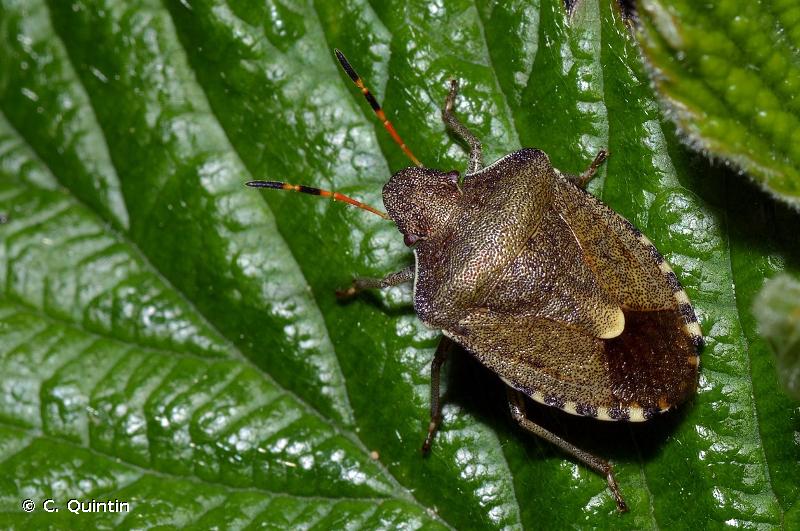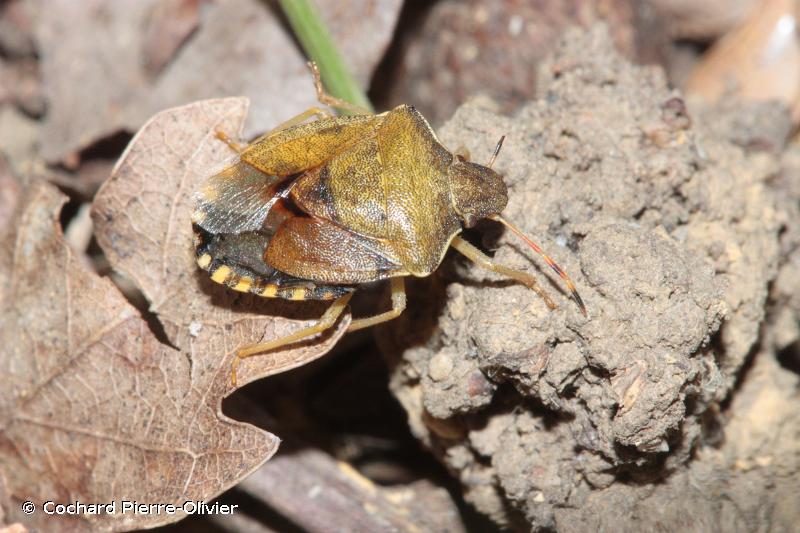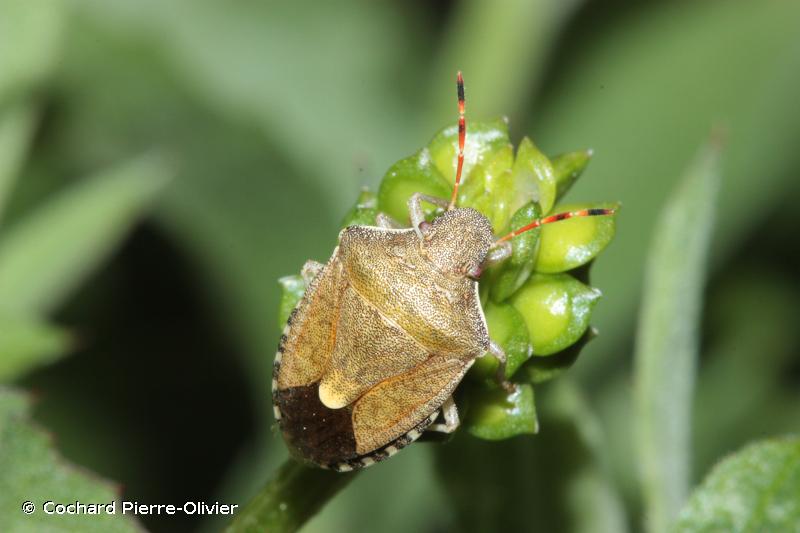
cd_nom

| Author : C. Quintin |
 |
To get the picture, please visit:
Christophe Quintin
email : inpn@mnhn.fr
Despite the Creative Commons license, please inform the author of the use which will be made of his photo

| Author : Cochard Pierre-Olivier |
 |
Despite the Creative Commons license, please inform the author of the use which will be made of his photo

| Author : Cochard Pierre-Olivier |
 |
Despite the Creative Commons license, please inform the author of the use which will be made of his photo
Taille : 8 – 10,5 mm
Diagnose :
Petite punaise de couleur marron foncé. Les bords latéraux de son pronotum sont concaves et bordés d'une ligne blanche fine. Ses articles antennaires III sont aussi longs que les II, et les articles I, II et III ont une coloration jaune-orangé relativement homogène, articles IV et V pourvus d'un anneau noir en leur centre. Elle a le clypéus (nez) enclos par les jugas (joues). Son scutellum n'est pas ponctué jusqu'à l'apex et laisse donc une tache claire à son extrémité.
Détermination : Moyennement difficile.
Espèces proches :
On la distingue des Holcostethus qui sont proches mais qui n'ont pas le clypéus enclos par les jugas. Proche de Peribalus strictus strictus qui n'a pas d'anneau noir sur les articles antennaires IV et V, et dont le scutellum est ponctué presque jusqu'à son apex ne laissant pas une tache claire apparaitre.
Période d'observation :
Mars à novembre, avec un pic principal en mai et un autre en août.
Biologie-éthologie :
Espèce polyphage se nourrissant de nombreuses espèces d'arbustes et plantes herbacées, appartenant aux Scrophulariacées (molènes), Adoxacées (sureaux), Astéracées, Rosacées (arbres fruitiers du genre Prunus, ronces), crucifères, légumineuses, et ombellifères.
Biogéographie et écologie :
Elle a une distribution eurosibérienne, présente à travers toute l'Asie centrale jusqu'en Sibérie orientale. Elle est absente de la zone méditerranéenne sauf dans les secteurs frais d'altitude (étage supraméditerranéen). Elle est très commune jusqu'à 1 850 m, dans une variété de milieux ensoleillés, plutôt humides : lisières forestières (chênaies claires et autres feuillus), landes, pelouses, prairies, friches, marais, tourbières, bords de rivières boisés, jardins, bordures des cultures.
Roland Lupoli (),2020
Continental
Metropolitan France
Overseas
Marine
Metropolitan France
Overseas
The map presents a summary at the 10 x 10 km grid of the observation data for the species transmitted to the SINP. These data have been subjected to validation filters.
The map presents a reference distribution layer of the species at the scale of departments and marine sectors. The presence and absence data were established by expertise within a network of partners. This reference distribution is used in the validation process of the SINP data at the INPN level.
Corresponds to a report on the basis of at least one observation proved within a period of 10 years (20 years for little-known invertebrates) preceding the year and no presumption of extinction since obtaining the last data nor doubt on reproductive and implemented nature of this population. For migratory species, the presence indicated concerns areas of reproduction.
This status is based on one or more of the following criteria:
This point covers the absence, more difficult by nature to demonstrate than presence. This status is based on one or more of the following criteria:
This status must be assigned to a department in which the presence of the species is casual.
Particular case of absence due to a proven extinction less than a half century ago (older disappearances are treated as "no probable or definite").
In the state of knowledge, we can not comment on the presence or absence in the current department. This is the default status when not comprised in one of the previous categories or whenever there is doubt.
The map shows the global distribution of the species based on GBIF data (Global Biodiversity Information Facility).
